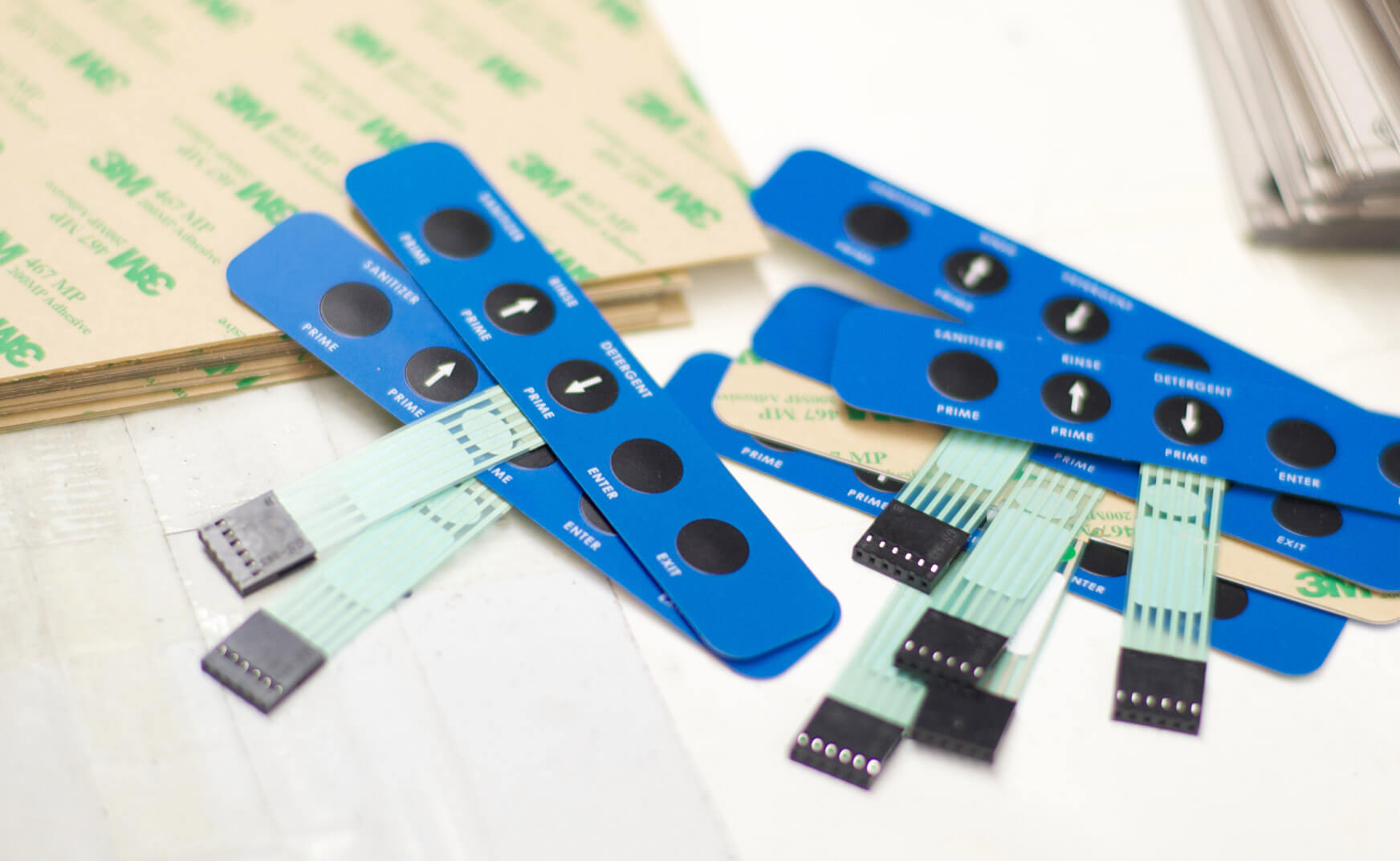How Membrane Switches Improve Durability in Harsh Environments
How Membrane Switches Improve Durability in Harsh Environments
Blog Article
Understanding the Significance of Membrane Switches in User User Interfaces
Membrane buttons are essential elements in the design of efficient customer interfaces, assisting in not only capability but likewise enhancing aesthetic charm and individual interaction. As we check out the future trends and various advantages associated with Membrane innovation, it ends up being clear that these buttons are more than just components; they stand for a merging of technology and usefulness.
What Are Membrane Switches?

The spacer layer, which includes glue properties, permits the separation of the circuit layer from the overlay, making sure that the button remains in a non-activated state up until pushed. When pressure is related to the overlay, it compresses the spacer layer, linking the gap and finishing the circuit in the underlying layer. This design not only minimizes the physical space needed for conventional mechanical switches but additionally boosts the durability of the gadget, as Membrane buttons are usually resistant to dirt, dampness, and other ecological variables.
Generally located in applications varying from consumer electronic devices to clinical tools, Membrane switches are essential to modern-day innovation, giving a straightforward and effective interface that aligns with contemporary design needs.
Benefits of Membrane Switches
While various button modern technologies exist, Membrane Switches offer distinctive advantages that make them especially desirable in various applications. Among the key advantages of Membrane buttons is their small layout, which enables for space-saving applications in devices where real estate is restricted. Their thin profile not just improves aesthetic appeal yet additionally promotes light-weight building.
One more considerable advantage is their resistance to ecological factors. Membrane switches are typically secured against dampness, dirt, and impurities, making them excellent for usage in demanding settings, such as medical devices and commercial devices. This resilience expands the life-span of the button, reducing maintenance prices and enhancing reliability.
In addition, Membrane buttons can be customized to meet certain style requirements, incorporating unique graphics and colors that boost user interaction. Their tactile comments alternatives can additionally be tailored to provide an enjoyable user experience. Furthermore, Membrane switches are cost-effective, particularly in high-volume applications, as they can be created effectively.
Applications in Different Industries

In the consumer electronics field, Membrane switches prevail in tools such as microwaves, washing equipments, and remote controls. Their tactile responses and aesthetic options enhance user experience while supplying a smooth, contemporary look. In addition, automotive makers utilize Membrane switches in dashboard controls and infomercial systems, where space is restricted, and user involvement is essential.
Furthermore, the commercial field leverages Membrane switches in control panels for equipment and equipment, enabling user-friendly operation in frequently extreme environments. Their resistance to chemicals and moisture makes sure longevity and dependability in these applications. In general, the flexibility of Membrane Switches contributes significantly to their prevalent use, making them indispensable in various technological domain names.
Style Factors To Consider for Membrane Buttons

When creating Membrane buttons, numerous key factors to consider need to be taken into account to guarantee optimal capability and customer experience. First of all, the selection of products is crucial; picking sturdy, top notch substrates can enhance the switch's long life and resistance to environmental factors such as moisture and temperature fluctuations.
Secondly, the style of the visuals overlay must prioritize clearness and ease of usage. Icons and text need to be legible, and the layout needs to facilitate user-friendly interaction (membrane switches). In addition, tactile comments is necessary; incorporating a responsive dome or other systems can enhance the user experience by giving physical verification of activation
An additional vital element is the switch's electric efficiency. Developers need to ensure that the conductive traces are correctly created to minimize resistance and stay clear of signal disturbance. This entails examining the needed actuation force and ensuring compatibility with the digital components they will interface with.

Future Patterns in Membrane Technology
As modern technology remains to breakthrough, Membrane switches are positioned to advance significantly, driven by advancements in materials and making strategies. One emerging fad is the unification of advanced products, such as adaptable substrates and conductive inks, which boost longevity and decrease the general weight of Membrane switches. These products not just improve the tactile response however also enable for the design of buttons that can withstand harsher environmental conditions.
Additionally, the combination of touch-sensitive technologies is transforming conventional Membrane Switches into even more interactive interface. Capacitive touch sensing units embedded within Membrane button panels can provide a much more responsive and user-friendly individual experience, straightening with the expanding demand for sleek, modern designs in consumer electronic devices.
Furthermore, advancements in printing techniques, such as digital and 3D printing, enable rapid prototyping and modification of Membrane switches. This versatility allows suppliers to react faster to market needs and consumer choices.
Lastly, sustainability is coming to be a substantial focus, with manufacturers checking out environmentally friendly products and processes. As these patterns unfold, the future of Membrane modern technology promises improved performance, aesthetic allure, and ecological duty, solidifying their role in sophisticated user interfaces throughout different markets.
Final Thought
In verdict, Membrane Switches stand for an important element in the design of individual interfaces, combining performance with aesthetic versatility. As developments in technology proceed, the development of Membrane buttons is anticipated to further refine customer interfaces, driving technology and enhancing usability in a progressively complex technical landscape.
Membrane buttons are integral parts in the layout of efficient user interfaces, promoting not just performance but also boosting aesthetic appeal and customer communication.Membrane Switches serve as an essential part in numerous user interfaces, promoting a smooth communication between users and electronic gadgets.While numerous switch technologies exist, Membrane like this Switches offer unique benefits that make them particularly preferable in various applications.Furthermore, Membrane buttons can be customized to meet specific design demands, integrating distinct graphics and shades that boost customer interaction.In conclusion, Membrane Switches represent an essential component in the layout of individual interfaces, incorporating functionality with visual flexibility.
Report this page